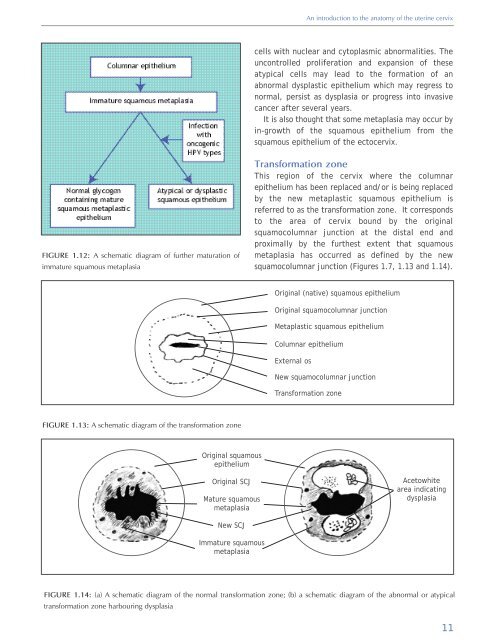Colposcopy and Treatment of Cervical Intraepithelial Neoplasia - RHO
Colposcopy and Treatment of Cervical Intraepithelial Neoplasia - RHO
Colposcopy and Treatment of Cervical Intraepithelial Neoplasia - RHO
Create successful ePaper yourself
Turn your PDF publications into a flip-book with our unique Google optimized e-Paper software.
An introduction to the anatomy <strong>of</strong> the uterine cervix<br />
cells with nuclear <strong>and</strong> cytoplasmic abnormalities. The<br />
uncontrolled proliferation <strong>and</strong> expansion <strong>of</strong> these<br />
atypical cells may lead to the formation <strong>of</strong> an<br />
abnormal dysplastic epithelium which may regress to<br />
normal, persist as dysplasia or progress into invasive<br />
cancer after several years.<br />
It is also thought that some metaplasia may occur by<br />
in-growth <strong>of</strong> the squamous epithelium from the<br />
squamous epithelium <strong>of</strong> the ectocervix.<br />
FIGURE 1.12: A schematic diagram <strong>of</strong> further maturation <strong>of</strong><br />
immature squamous metaplasia<br />
Transformation zone<br />
This region <strong>of</strong> the cervix where the columnar<br />
epithelium has been replaced <strong>and</strong>/or is being replaced<br />
by the new metaplastic squamous epithelium is<br />
referred to as the transformation zone. It corresponds<br />
to the area <strong>of</strong> cervix bound by the original<br />
squamocolumnar junction at the distal end <strong>and</strong><br />
proximally by the furthest extent that squamous<br />
metaplasia has occurred as defined by the new<br />
squamocolumnar junction (Figures 1.7, 1.13 <strong>and</strong> 1.14).<br />
Original (native) squamous epithelium<br />
Original squamocolumnar junction<br />
Metaplastic squamous epithelium<br />
Columnar epithelium<br />
External os<br />
New squamocolumnar junction<br />
Transformation zone<br />
FIGURE 1.13: A schematic diagram <strong>of</strong> the transformation zone<br />
Original squamous<br />
epithelium<br />
Original SCJ<br />
Mature squamous<br />
metaplasia<br />
Acetowhite<br />
area indicating<br />
dysplasia<br />
New SCJ<br />
Immature squamous<br />
metaplasia<br />
FIGURE 1.14: (a) A schematic diagram <strong>of</strong> the normal transformation zone; (b) a schematic diagram <strong>of</strong> the abnormal or atypical<br />
transformation zone harbouring dysplasia<br />
11
















